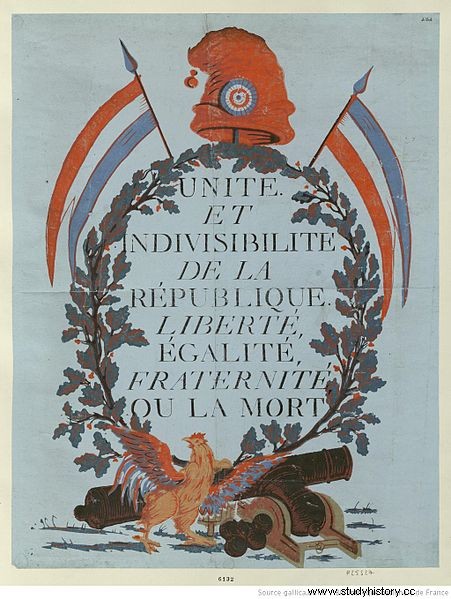- The revolutionary movement isolates France from the rest of monarchist Europe. The country is therefore confronted with internal threats (counter-revolution) as well as external ones (coalition of European monarchies) generating significant political and social tensions.
- In August 1791, the declaration of Pillnitz unites the European monarchical powers to fight against the French revolutionary threat; Louis XVI also participates in this movement. It is a question of maintaining the solidity and solidarity of monarchical Europe.
- On April 19 and 20, 1792, France entered the war against Austria by a vote of the deputies of the Legislative Assembly. The royal family hopes for the victory of Austria in order to be delivered from the revolutionary yoke.
- On July 11, 1792, the Legislative Assembly declared “the Fatherland in danger”. From then on, battalions of federates from the provinces arrived in Paris, notably those of Brest and Marseille. On July 15, 1792, Brunswick's manifesto threatens Paris with reprisals if the royal family is injured.
- On August 10, 1792, the attack on the Tuileries marked the end of the monarchy. The king and his family are imprisoned in the prison of the Temple by the Legislative Assembly. It is the end of the Old Regime and the advent of the National Convention.
- Until 1794, the sans-culottes, winners of August 10, would play a major political role. They are common people, modest craftsmen and city workers, sometimes poor peasants. They demand material equality and radical revolutionary measures. They are armed and organized into popular clubs. They are the living forces of the revolution. Their pressure on politicians is constant.
- On September 20, 1792, the victory at Valmy put an end to the coalition's advance in the country.
September 21, 1792 - November 8, 1799

Characters
Maximilian of Robespierre
Emmanuel Joseph de Sieyes
Napoleon Bonaparte
Jean-Jacques de Cambacérès
Charles-François Lebrun
Procedure
Formalized by the Convention the day after the victory at Valmy (September 21, 1792), the I re République is an unstable period in French political life. Following the abolition of the Ancien Régime, three successive governments were established before the advent of the First Empire:the Convention (September 21, 1792 – October 26, 1795), the Directory (October 26, 1795 – November 9, 1799) and the Consulate (November 10, 1799 – May 18, 1804).
Elected by universal suffrage on September 2, 1792, the members of the Convention established a pact with the nation – declared “one and indivisible” (September 25, 1792) – giving themselves the mission of pacifying and ordering the country through institutions strong. Seven hundred and forty-nine deputies, mainly of bourgeois origin, are distributed in the hemicycle:the Girondins (on the right), eager to stop the Revolution, confront the Montagnards (on the left) in favor of a more radical. The Plain or the Marais (in the center) is made up of opportunists, associating with the left or the right depending on the situation.
First Girondin, the Convention won several external successes including at Jemmapes on November 6, 1792. However, the Girondins were quickly discredited not only by the ambiguity of their position during the king's trial and the violent confrontations against the Montagnards but above all by the setbacks suffered in the spring of 1793 (March 18:defeat at Neerwinden; April 6, 1793:betrayal by Dumouriez). While the people suffered from great poverty and famine, the Girondins were gradually removed from power. Some were arrested under popular pressure on June 2, 1793 under popular pressure.
The Convention, now Montagnard, wishes to continue the Revolution in a country in the midst of civil war. All efforts are focused on the pacification of the territory by establishing an authoritarian government instigator of the Terror. Thus all the opponents of the regime, proven or supposed, are sent to the “national razor” by a revolutionary tribunal and a Committee of Public Safety. Robespierre had the most radical and moderate members of the convention executed:Enraged and Indulgent were guillotined. Having become a threat to the deputies, Robespierre was arrested on July 27, 1794 following a plot against him, which put an end to the Terror. The next day, the Thermidorians seized power but the situation in the country remained critical.
The revolutionary government was dismantled in favor of the renewal of a bourgeois republic laying the foundations of the Directory by the promulgation of the constitution of Year III (October 26, 1795). Organized to avoid the dictatorial exercise of power, the regime guarantees the independence of its organs whose functions are distinct (the Directors, the Councils of Elders and Five Hundred). This regime was repealed by the coup of 9 Brumaire orchestrated by Abbé Sieyès and Napoleon Bonaparte, then crowned by his military victories. The next day, the Consulate is set up around the triumvirate (Bonaparte, Cambaceres, Lebrun). However, all power is held by Napoleon, appointed First Consul.
Consequences
- The effects of the Revolution reveal the divergent ambitions of these members who constantly tear each other apart to the detriment of national well-being. The constant confrontations between republicans and royalists favor conspiracies and coups often to the detriment of the people suffering from misery and famine. This new context led to an increase in popular violence which was revealed from the September massacres.
- This permanent instability between 1792 and 1799 supported the rise of Napoleon Bonaparte, who appeared to be the only way out of this political, economic and social crisis by establishing a new regime, the Empire (Constitution of Year XII). Indeed, under the Consulate, the chaotic situation in France was improved by a rigorous government policy aimed at definitively pacifying the country, building strong national institutions capable of supervising the development of society.
- The advent of Napoleon Bonaparte led the country into a dictatorial regime in which the French nation and the cult of the emperor were put forward, allowing France to shine.
